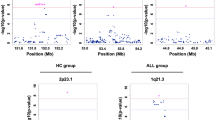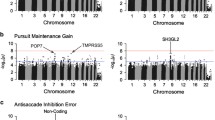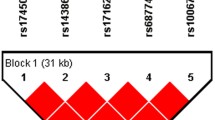Summary
Eye movement dysfunctions have been found in a large number of schizophrenic patients and in about half of their first-degree relatives. The distribution of these traits within the families of schizophrenic patients suggests a model of genetic transmission that fits an autosomal dominant model, which we have called the “genetic latent trait model.” The model, with seven parameters, was fitted to a U.S. population and the model was cross-validated on an independent Norwegian sample. Although the model does not invalidate other, more conventional solutions to the puzzle of schizophrenic transmission, such as multifactorial transmission, the latent trait model does more easily permit linkage studies and therefore will allow refutation or support from the use of molecular genetics techniques.
Similar content being viewed by others
References
Brezinova V, Kendell RS (1977) Smooth pursuit eye movements of schizophrenics and normal people under stress. Br J Psychiatry 130:59–63
Cegalis JA, Sweeney JA (1979) Eye movements in schizophrenia: A quantitative analysis. Biol Psychiatry 14:13–26
Diefendorf AR, Dodge R (1908) An experimental study of the ocular reactions of the insane from photographic records. Brain 31:451–489
Holzman PS (1988) A single dominant gene can account for schizophrenia and eye movement dysfunctions in the family. In: Dunner DL, Gershon ES, Barrett JE (eds) Relatives at risk for mental disorder. Raven Press, New York, pp 299–314
Holzman PS, Proctor LR, Hughes DW (1973) Eye tracking in schizophrenia. Science 181:179–180
Holzman PS, Proctor LR, Levy DL, Yasillo, Meltzer HY, Hurt SW (1974) Eye tracking dysfunctions and schizophrenic patients and their relatives. Arch Gen Psychiatry 31:143–151
Holzman PS, Kringlen E, Levy DL, Proctor LR, Haberman S, Yasillo NJ (1977) Abnormal pursuit eye movements in schizophrenia. evidence for a genetic marker. Arch Gen Psychiatry 34:802–805
Holzman PS, Kringlen E, Levy DL, Haberman S (1980) Deviant eye tracking in twins discordant for psychosis: a replication. Arch Gen Psychiatry 37:627–631
Holzman PS, Solomon CM, Levin S, Waternaux CS (1984) Pursuit eye movement dysfunctions in schizophrenia: family evidence for specificity. Arch Gen Psychiatry 41:136–139
Holzman PS, Kringlen E, Matthysse S, Flanagan S, Lipton R, Cramer G, Levin S, Lange K, Levy D (1988) A single dominant gene can account for eye tracking dysfunctions and schizophrenia in offspring of discordant twins. Arch Gen Psychiatry 45:641–647
Iacono WG, Tuason VB, Johnson RA (1981) Dissociation of smooth pursuit and saccadic eye tracking in remitted schizophrenics. Arch Gen Psychiatry 38:991–996
Klein RH, Salzman LF, Jones F, Ritzler B (1976) Eye-tracking in psychiatric patients and their offspring. Psychophysiology 13:186
Kringlen E (1967) Heredity and environment in the functional psychoses. Norwegian Monographs on Medical Science. Universitetsforlaget, Oslo
Kuechenmeister CA, Linton PH, Mueller TV, White HB (1977) Eye tracking in relation to age, sex, and illness. Arch Gen Psychiatry 34:578–599
Levy DL, Yasillo NJ, Dorus E, Shaughnessy R, Gibbons RD, Peterson J, Janicak PG, Gaviria M, Davis JM (1983) Relatives of unipolar and bipolar patients have normal pursuit. Psychiatr Res 10:285–293
Matthysse S, Holzman PS, Lange K (1986) The genetic transmission of schizophrenia: application fo Mendelian latent structure analysis to eye tracking dysfunctions in schizophrenia and affective disorder. J Psychiatr Res 20:57–65
May HJ (1979) Oculomotor pursuit in schizophrenia. Arch Gen Psychiatry 36:827
Mialet JP, Pichot P (1981) Eye tracking patterns in schizophrenia. An analysis based on incidence of saccades. Arch Gen Psychiatry 38:183–186
Pass HL, Salzman LF, Klorman R, Kaskey GB, Klein RB (1978) The effects of distraction on acute schizophrenics visual tracking. Biol Psychiatry 13:587–593
Saletu B, Kufferle B, Grunberger J, Anderer P (1986) Quantitative EEG, SPEM, and psychometric studies in schizophrenics before and during differential neuroleptic therapy. Pharmacopsychiatry 19:434–437
Salzman LF, Klein RH, Strauss JS (1978) Pendulum eye tracking in remitted psychiatric patients. J Psychiatr Res 14:121–126
Shagass C, Amadeo M, Overton DA (1974) Eye-tracking performance in psychiatric patients. Biol Psychiatry 9:245–260
Siegel C, Waldo M, Miznor G, Adler LE, Freedman R (1984) Deficits in sensory gating in schizophrenic patients and their relatives. Arch Gen Psychiatry 41:607–612
Schmid-Burgk W, Becker W, Diekmann R, Jurgens R, Kornhuber HH (1982) Disturbed smooth pursuit and saccadic eye movements in schizophrenia. Arch Psychiatr Nervenkr 232:381–389
Schmidt-Burgk W, Becker W, Jurgens R, Kornhuber HH (1983) Saccadic eye movements in psychiatric patients. Neuropsychobiology 10:193–198
Tsuang MT, Winokur G, Crowe RR (1980) Morbidity risks of schizophrenia and affective disorders among first degree relatives of patients with schizophrenia, mania, depression and surgical conditions. Br J Psychiatry 137:497–504
Author information
Authors and Affiliations
Rights and permissions
About this article
Cite this article
Holzman, P.S. The use of eye movement dysfunctions in exploring the genetic transmission of schizophrenia. Eur Arch Psychiatr Neurol Sci 239, 43–48 (1989). https://doi.org/10.1007/BF01739743
Received:
Issue Date:
DOI: https://doi.org/10.1007/BF01739743




